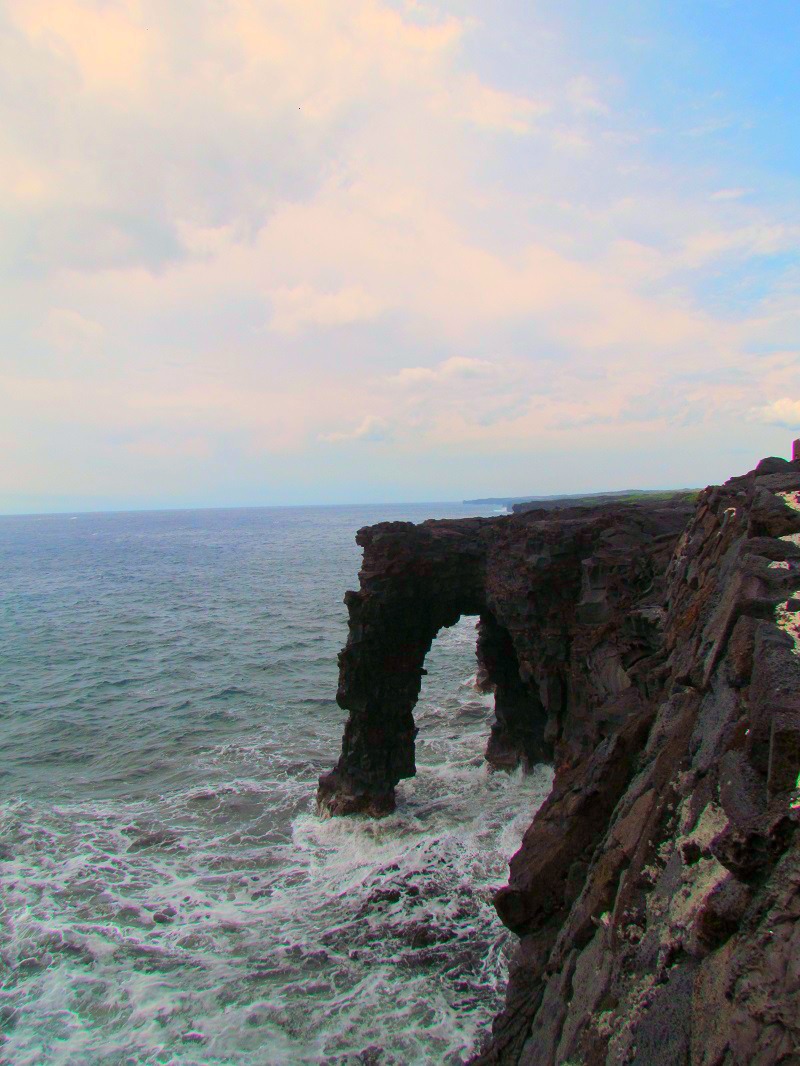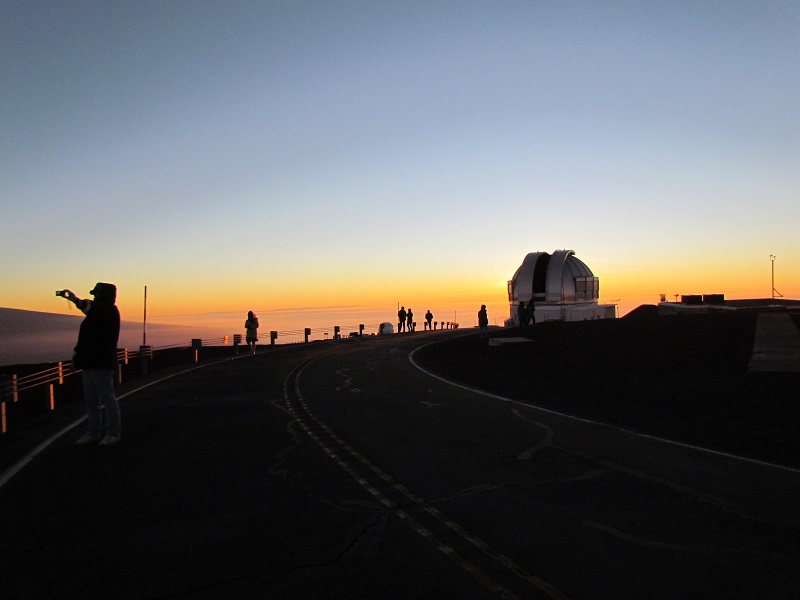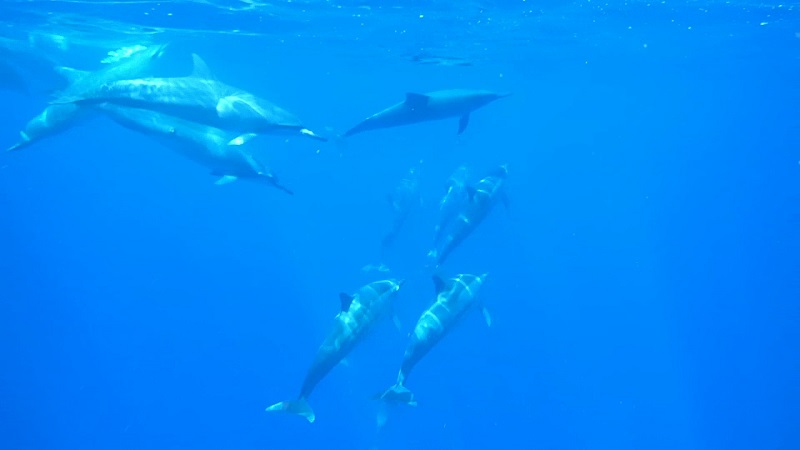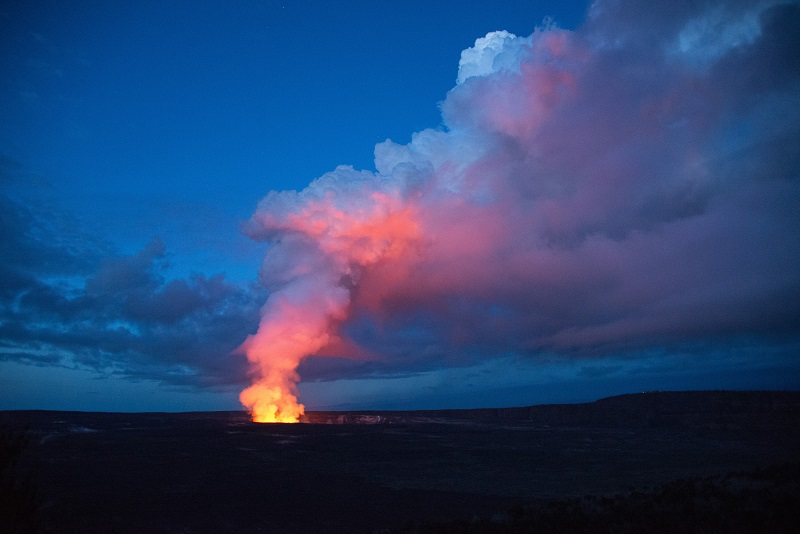Trek to a lava flow, learn to navigate by the stars or snorkel with dolphins on the Big Island.

The Holei sea arch at the end of Chain of Craters Road was once a lava flow – Photo Debra Smith
It’s easy to learn when you’re having fun. On Hawai’i Island, a love of nature and a love of learning go hand in hand. Guides, docents and rangers who are passionate about Hawai’i are happy to answer every question your kids can come up with. Here are three ways to find out more about the sea, the stars and everyone’s favourite Hawai’ian topic – lava.
Starry, starry night
“I love to drive at night”, says Brett Weast, our guide from Hawaii Forest & Trail. “In fact, I don’t know why the island has any streetlights at all.” Brett loves the night sky so much that he took up astronomy and started leading tours to the top of Mauna Kea.

Sunsets are breathtaking at the summit in part due to the altitude – Photo Debra Smith
Thirteen huge bullet shaped telescopes dominate the barren plateau at 4,200 meters above sea level. The observatories are usually built by several countries working together. Canada, France and Hawaii jointly operate a 3.5-meter telescope that searches for distant objects in space. Japan’s 8-meter telescope is currently on the lookout for Planet X, the Neptune sized Colossus discovered in January 2016. Although you can’t enter the facilities, the view of the sunset is amazing.
At the Visitors Center, a short drive down from the plateau, Weast tells us about the legends surrounding Mauna Loa, which is sacred ground to the Hawai’ian people. In the pitch blackness, he sets up an 11 inch Celestron telescope for us to stargaze with. While we wait our turn for a peek through the lens, he teaches us how to find Polaris, the North Star, and the axis of the planets, constellations and the Milky Way. We get some basic lessons in celestial navigation, the same method used by the first people who sailed to Hawaii. Soon we’re all holding our hands up like novice sailors. If you love the night sky, prepare to be starstruck. Most people can see an average of 20 stars in a city at night. On Mauna Kea, you can see over 2,000 stars with the naked eye.
Tip: You can drive as far as the Mauna Kea Visitor Information Station in a rental car. The VIS runs a free stargazing program, weather permitting, several nights a week from 6 to 10 p.m. Check their website for details.
Under the Sea
We had great luck on our half-day tour with Coral Reef Snorkel Adventures. Within a half-hour we watched a manta ray skim the sea floor on its huge white wings and a mother humpback whale and her calf put in an appearance, at one point swimming right under our boat. As we reached our snorkel spot, dozens of local spinner and spotted dolphins popped up on the surface.

Friendly dolphins dropping by to say aloha – photo Wallace Tobin
Dolphins love to hang around the Kona and Kohala coast and responsible small group tour companies like Coral Reef Snorkel can get up close without endangering them. They have a “look but don’t touch” policy for all sea life that’s strictly enforced. Snorkelling with dolphins is a pure joy as they form ranks, rush to the surface and shoot through the air around you. During the tour, the onboard naturalist will fill you in on the lives and habits of dolphins, whales, manta rays and seabirds.
Tip: The half day tour includes all your gear, lunch, bottled water and soda and the most delicious brownies on the island.
Finding a hot spot
There are many ways to spend some time with Madam Pele, the revered volcano goddess. The easiest way is to drive to Hawai’i Volcanoes National Park on the Hilo side of Hawai’i Island. Hike by hissing steam vents, walk through lava tubes and explore ancient calderas. Then visit the Jaggar Museum to catch a glimpse of bubbling lava in the Halemaumau Crater of the Kilauea volcano. If you go at sunset, you’ll see the reflection of the churning lava lake reflected in the clouds.

Kilauea volcano at dusk – photo courtesy Hawaii Volcanoes National Park
For more adventurous souls who want a closer look at the lava flow, there are boat tours and helicopter rides. Lava boats will take you to within 300 meters outside the safety zone established by the Coast Guard to see the lava cascading down newly formed cliffs. For airborne fun, Paradise Helicopters is a well-established operator that flies “doors off” for great photographs. You can also take a 14 kilometre round trip hike from the west from Highway 130 or east from the base of Chain of Craters Road but be prepared. This is no walk in the park. There are many hazards including glass-like shards of new lava, uneven terrain and possible exposure to rain, wind, heat, dust and clouds of noxious gas. Bring lots of water, a flashlight, long pants, long sleeved shirts, gloves, closed toe shoes or boots and a hat. Obey all safety signs and the Park Rangers. The road may be closed due to unexpected lava flows.
Tip: Check the Hawai’i Volcanoes National Park lava viewing page for all the details before you go and however you get there, don’t forget to pay your respects to Madam Pele.




